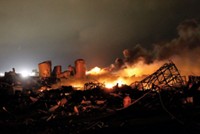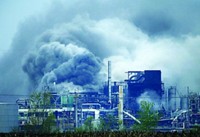Advertisement
Grab your lab coat. Let's get started
Welcome!
Welcome!
Create an account below to get 6 C&EN articles per month, receive newsletters and more - all free.
It seems this is your first time logging in online. Please enter the following information to continue.
As an ACS member you automatically get access to this site. All we need is few more details to create your reading experience.
Not you? Sign in with a different account.
Not you? Sign in with a different account.
ERROR 1
ERROR 1
ERROR 2
ERROR 2
ERROR 2
ERROR 2
ERROR 2
Password and Confirm password must match.
If you have an ACS member number, please enter it here so we can link this account to your membership. (optional)
ERROR 2
ACS values your privacy. By submitting your information, you are gaining access to C&EN and subscribing to our weekly newsletter. We use the information you provide to make your reading experience better, and we will never sell your data to third party members.
Safety
New Voices for Plant Security
Chemical, rail unions want company antiterrorism planning to include workers
by JEFF JOHNSON, C&EN WASHINGTON
November 22, 2004
| A version of this story appeared in
Volume 82, Issue 47

Chemical and transportation workers who make, use, or move large quantities of hazardous materials are on the front lines of a battle to keep terrorists from employing industrial chemicals as weapons of mass destruction. Yet unions that represent these workers say their members are in the dark about what precautions companies may be taking to lower the risk or impact of a terrorist attack.
Unions also warn that from what they see, companies are relying mostly on security measures--guns, guards, and gates--rather than taking steps to reduce the impact of a chemical explosion or release at an industrial site. Consequently, union workers worry that they may be sitting ducks in the case of a successful terrorist attack.
That view was brought home in a recent survey of chemical workers by the Paper, Allied-Industrial, Chemical & Energy Workers International Union (PACE) and at a Nov. 10 workshop in Washington, D.C., at the national meeting of the American Public Health Association (APHA).
The workshop brought together a half-dozen unions that take part in an emergency planning and response training program funded by the National Institute of Environmental Health Sciences' (NIEHS) Worker Education & Training Program (WETP).
Over 17 years, the program has trained more than 1 million workers to safely handle hazardous materials and to respond to disasters involving these chemicals. WETP has provided training grants and aid to a host of nonprofit organizations, such as unions, firefighter associations, universities, and others.
After the Sept. 11, 2001, terrorist attacks, the NIEHS program began to refocus its training program to respond and prepare for terrorism-related disasters as well as industrial accidents, says WETP Director Joseph (Chip) Hughes. On the day following the 9/11 attack, Hughes says, NIEHS-supported investigators were at the World Trade Center site conducting exposure assessments and epidemiological studies and reaching out to the community.
Last year, WETP announced some $4.5 million in funding for 12 worker training programs to focus on incidents caused by weapons of mass destruction. But Hughes worries that an emergency response most likely will be inadequate to address a large-scale incident, particularly one caused by a terrorist attack. Hence, he urges that antiterrorism measures enhance prevention, including inherently safer processes and less on-site storage of hazardous chemicals.
His view was echoed by a range of speakers at the APHA workshop who warned that hospitals and police, firefighters, and other emergency personnel would be overwhelmed trying to meet the public's needs during a large disaster.
SPEAKING FOR PACE was Thomas H. McQuiston, senior associate for program research and development, who said that after 9/11 his union emergency response training programs have emphasized preventing accidents as well as responding to them.
"The potential of a large accident is just too great," he told C&EN. "The majority of people who are hurt in accidents are workers, and chemical workers are going to get hurt first. We have to see how we can intervene to protect these workers and not just prepare to respond and by default say these workers are just going to be casualties."
Consequently, PACE has added more information to its worker emergency response training programs on the potential damage terrorists can inflict on an industrial site. And last month, the union released a new workbook, "Controlling Weapons of Mass Destruction through Prevention," for use in its workplace-centered training programs. PACE plans to reach 3,000 workers in 2005 with its antiterrorism security training program.
Also, in the wake of 9/11, many chemical companies, refineries, and transporters of chemicals say they have added a mix of security measures to lower the risk of a terrorist attack. In the chemical and petrochemical sector, the American Chemistry Council, the Synthetic Organic Chemical Manufacturers Association, and the American Petroleum Institute are among trade associations that have created and that oversee self-monitored terrorism security programs at their member companies.
But these associations represent a small number of the 15,000 plants identified by the Environmental Protection Agency as facilities that handle large amounts of hazardous materials and face a threat from terrorists. And even for these companies, it is unclear what they have done because their actions are confidential.
At least a quarter of the 15,000 plants are chemical companies or refineries, EPA says, and the agency estimates that an incident at any one of some 3,000 of these sites could put more than 10,000 people at risk from a large chemical release--whether from an accident or an attack.
Yet there is no federal requirement for implementation of security measures for these sectors and no regulations requiring some sort of independent oversight or public reporting of their actions. These trade associations now want a national program like theirs to be required for all companies, but legislation is stalled over government oversight of such a program and whether inherently safer designs and other accident prevention measures should be included in antiterrorism plans. The companies do not support inherent-safety requirements (C&EN, March 31, 2003, page 19).
TO TRY TO get a handle on the problem from the workers' perspective, last spring PACE began a survey of the chemical and refinery workers it represents. The union found 189 plants it represents that are among the 15,000 EPA-identified plants.
These plants employ 50,437 PACE members and include 77 chemical plants, 44 refineries, 46 paper mills, two nuclear plants, and 20 miscellaneous facilities, the union says. Company names and locations are held in confidence, but PACE represents workers at the nation's largest chemical plants and refineries, many of which are trade association member companies that have done terrorism vulnerability studies and taken some level of antiterrorism measures.
Union leaders at 125 of the plants responded to the survey in what is the first look at security from the point of view of someone working in a potential target plant.
In a nutshell, PACE found that 73% of the 125 plants have added guards and fences since 9/11. Also, about two-thirds of the plants have assessed their vulnerability to a terrorist attack and fewer than half have taken some preventive measures to reduce the impact of a catastrophic event (C&EN, Nov. 8, page 13).
At fewer than 17% of the facilities, companies have made more fundamental changes that would lower the impact of an accident or attack by making chemical processes inherently safer or by storing smaller amounts of hazardous materials on-site, according to the worker survey.
"We discovered a dichotomy," McQuiston says, "where the things that are the least preventative and easiest to do were done most and the things that were the most preventative and generally safer were done least."
The survey also found that most workers were not involved in developing plans to respond to or prevent an attack and were unaware if companies had informed communities near the plant of the potential threat from an attack or accident at the site.
Most of the workers (75%) wanted more training in how to respond to an accident or attack, he adds.
The survey, PACE notes, was based on perceptions and is not an independent assessment of company actions. However, the survey remains the only outside look at antiterrorism measures taken by companies.
The trade associations have reported a broad overview of what they have done. The American Chemistry Council, for instance, reports that, of its nearly 2,000 member plants, 120 consider themselves to be most vulnerable to a terrorist attack and have implemented security measures; another 882 are somewhat vulnerable and are taking measures on a phased schedule; and 950 consider themselves not to be vulnerable and are not required to take actions. No information is available on what approaches were taken by the companies.
THE SIGNIFICANCE of PACE's study was noted by Carolyn W. Merritt, president of the Chemical Safety & Hazard Investigation Board, an independent federal body that investigates chemical accidents. Merritt, a retired chemical process supervisor, says PACE survey results reflect some of what has been found by the board during its accident investigations. Particularly, she says, the board has seen a need for better communication between the companies and emergency responders, the community, and workers in the case of an accident. "It makes no difference if the incident is due to an attack or an accident," she notes. "The results are going to be the same."
Several railroad worker unions are also beginning similar surveys, according to officials with the Brotherhood of Locomotive Engineers & Trainmen and the Brotherhood of Maintenance of Way Employees.
At the APHA conference, Ruth Ruttenberg, a labor consultant who is working with the rail unions, warned that 1.7 million carloads of hazardous materials travel in the U.S. each year. Nearly half of some 60,000 tank cars are so old they don't meet current industry standards, and, she added, twice as many people live within 1 mile of a major rail line than live the same distance from a major highway.
Rail workers, she said, have had little training; mostly they have just been told to report suspicious activities to their supervisors. The unions, Ruttenberg said, want limits on who can enter a rail yard, photo identification for workers, locks on locomotive doors, and more training for workers.
Rail security is tough, she noted, with hundreds of thousands of miles of rails. Any protective solution for workers and residents should lean toward an overall protective design and a well-thought-out plan to prevent attacks or accidents, she said, similar to the measures desired by PACE.
Ruttenberg and Carin Zelenko, a Teamsters Union official who is also working with rail workers, say they hope to have survey results and a more accurate picture of railroad security next year. Right now, both say rail workers are unaware of what measures are being taken by the railroad companies.
PACE's McQuiston asks, "How can a terrorist response plan be effective if the people who are going to be at the epicenter don't know about the plan?
"We are just starting to scratch the surface of what can be done," he continues. "So far, we have brought workers together from different companies to begin discussing these issues. They learned what the others are doing and what works, and they take this information back to their plants.
"What we want to do," McQuiston says, "is move forward and have the workers join together and, we hope, engage their managers in a national dialogue about preventive and security options."





Join the conversation
Contact the reporter
Submit a Letter to the Editor for publication
Engage with us on Twitter